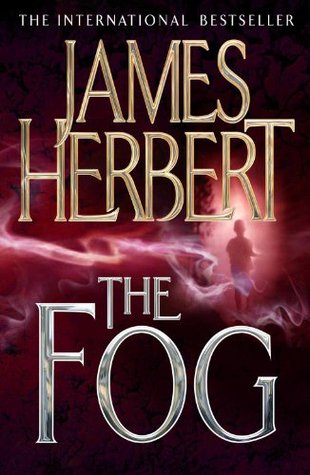 By JAMES HERBERT (New English Library; 1975/2010)
By JAMES HERBERT (New English Library; 1975/2010)
Impossible though it might seem to believe nowadays, this British horror fest, THE FOG, was once considered the height of shock. It was subjected to a great deal of critical scolding, and had an entire chapter devoted to it in Stephen King’s seminal nonfiction study DANSE MACABRE, where it was used as an example of its late author James Herbert’s aim to “assault the reader with horror.”
…author James Herbert’s aim to “assault the reader with horror.”
In the manner of most of Herbert’s early work, THE FOG is pulpy and sensationalistic, reveling in brutal set-pieces that pivot on various far-flung Britons meeting grisly deaths at the hands of each other. A fissure has opened up in the ground, which has released a manmade chemical agent that causes people to lose their inhibitions, leading, of course, to madness and murder.
This is a concept that has become quite popular in the years since THE FOG was first published, but in truth it wasn’t that unique in 1975, either. By then it was already old hat in the smut fiction field, having been utilized in THE POLLUTERS by R.L. Seiffert, MINDBLOWER by Brian McNaughton Jr. and, most notoriously, THE GAS by Charles Platt. The latter in particular makes for an interesting comparison with Herbert’s novel; it’s a good thing THE GAS was confined to the underground sphere, as it outdoes THE FOG in every conceivable respect (THE GAS, after all, actually got its author jailed, something THE FOG can’t claim).
…THE FOG is pulpy and sensationalistic, reveling in brutal set-pieces that pivot on various far-flung Britons meeting grisly deaths at the hands of each other.
But anyway, THE FOG, a horror novel (a realm that in most literary circles is only slightly elevated from that of smut fiction), is certainly diverting. The fog is released from an underground fissure into a sleepy village, where John Holman, an unassuming government agent, is among the first to inhale it. He goes nuts for a time but recovers pretty quickly (the fog’s precise effects on the brain, and why some folks get over them faster than others, are never entirely clarified), and becomes the closest thing this book has to a hero.
The overall structure is similar to that of Herbert’s first and most famous novel THE RATS, which, you may recall, consisted primarily of chapters devoted to filling in the backgrounds of characters who at the end of those chapters died horribly. Here the unfortunate characters, who are either driven crazy by the fog or victimized by others (why some characters retain their sanity while others don’t is another unexplained conundrum), include a farmer stomped by cows, a reverend who urinates all over his congregation, a stuffy businessman who in the middle of a meeting opens a window and jumps to his death, a pigeon enthusiast pecked to death by his birds, a guy who embarks on a butt kicking spree, etc.
The overall structure is similar to that of Herbert’s first and most famous novel THE RATS, which, you may recall, consisted primarily of chapters devoted to filling in the backgrounds of characters who at the end of those chapters died horribly.
As Herbert concedes in a newly written forward, only two portions of this supposed shock-fest are really all that shocking. The first occurs in a boarding school whose headmasters and students are affected by the fog in ways that might render this book unpublishable today, and the second in an airplane whose fog-afflicted pilot flies it into a high rise—a passage that obviously has an entirely different resonance today than it did in ‘75. Some miscellaneous sexual shenanigans are also included in the final chapters, in which mass orgies become the norm, but this stuff will seem pretty tame compared to anyone who’s read the aforementioned Charles Platt novel (although if you haven’t you may well be scandalized).
The wraparound plot involves Holman’s girlfriend Casey becoming affected by the fog and an investigation into the substance’s origins. The latter is among the book’s less invigorating portions, and is capped with a very Hollywood ending in which an explosion provides the ultimate solution to this particular problem.
